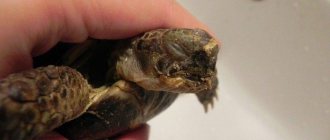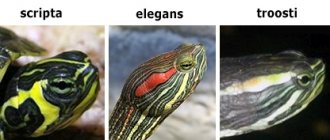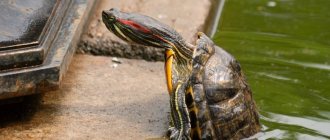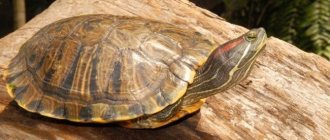The red-eared turtle is one of the most common pets. We fell in love with the turtle for its unusual bright color and its ease of care. However, many do not know the rules for keeping a turtle or simply ignore the recommendations of veterinarians and pet store sellers. This leads to problems with her health and physical condition. It often happens that after buying a red-eared turtle, the owners bring it home and notice that it is inactive, sleeps most of the time, is lethargic, and refuses to eat. In fact, there are a huge number of reasons for the occurrence of such syndromes, so let's look at the conditions in which the turtle is kept in order to eliminate our own fault.
A little about the red-eared slider
The red-eared beauty comes from America, it’s not for nothing that its second name is American turtle . This pet will be a great friend because... At home and with proper care, turtles are active and very hardy.
These pets often have a distinct personality and character, and are very intelligent and quick-witted.
If you have two individuals, you can observe the aggressive antics of the red-eared slider - taking food, fighting, rivalry.
At home, turtles live quite a long time, up to 40 years.
Another pleasant bonus of purchasing such an animal is the absence of allergies to it. The red-eared beauty is known for its striking olive-colored coat, with a red stripe running across its entire body.
The size of an individual varies - from 3 cm to 30 cm, and it is worth considering that at home, red-eared turtles develop much faster than in nature.
A turtle can make characteristic sounds - hissing, squeaking or snorting.
Anaerobic respiration process
After inhaling, the turtle slowly sinks, the processes of oxygen absorption from the lungs into the blood continue for the next 10-20 minutes. Carbon dioxide accumulates without causing irritation or requiring immediate exhalation, as in mammals. At the same time, anaerobic respiration is activated, which at the final stage of absorption replaces gas exchange through the lung tissue.
During anaerobic respiration, tissues located at the back of the pharynx, in the cloaca, are used - the layering makes these pads look like gills. It only takes a few seconds for the animal to remove carbon dioxide and then take in air again when ascending. Most species exhale sharply into the water before raising their head above the surface and drawing in air through their nostrils.
How to care for red-eared turtles
To keep a turtle you will need an aquarium. Choose the size yourself, but keep in mind that turtles grow quickly and in the future they will need a lot of space.- It is also worth building an island for access to land. The island must be installed so that part of it is covered with water. It should be secured well so that the turtle does not get hurt.
- And most importantly, the island must be heated and warm so that the reptile can bask on it.
- We strongly recommend purchasing a heating lamp to maintain the required temperature.
- To prevent the turtle from suffering from rickets or a curved shell, you will need to purchase a UV lamp, which will help the body absorb calcium correctly.
- Monitor your turtle's diet if you want it to be healthy.
The types of food are very diverse; they can be vegetables, special foods, insects or plants. The main condition is a large amount of calcium in the products, which is necessary for the formation of the shell.
The diet should be age appropriate.
Young reptiles are less demanding, while adults need plant food, which should be in abundance.
Water is the main condition for keeping a red-eared turtle. There should be a lot of water, and it needs to be changed often, because... pets live in this water, eat, and go to the toilet. Otherwise, reptiles may get sick from microbes that develop in dirty water.
It is necessary to constantly maintain the water temperature at 23 °C and above.
At low temperatures, the reptile may go into hibernation, from which it may not emerge, and then die from dehydration.
A turtle's claws and beak grow very quickly, and they also require special care. As the claws grow, they need to be trimmed, otherwise the pet will not be able to move on land. You can do this yourself or by visiting a veterinary clinic.
Keeping a red-eared turtle at home Video
Attention! Never trim the growing beak; it provides turtles with the opportunity to eat meat.
Improper care
The red-eared turtle is a cold-blooded animal; in order for it to be comfortable, the ambient temperature should be from 26 to 35 degrees.
A UV lamp is required to maintain the required temperature. You also need an incandescent lamp with a 40-watt bulb, which must be turned on for 12 hours a day.
When reptiles are cold, they not only refuse food, but also look lethargic, float on the surface and cannot dive. As soon as the ambient temperature is optimal, the animals’ appetite will normalize. If this does not happen, then it is not a case of hypothermia and the help of a veterinarian is required. It must be remembered that overheating is just as dangerous for reptiles as hypothermia.
Respiratory system device
In mammals, including humans, when breathing, the diaphragm increases and air is drawn into the lungs - movable ribs allow this to be done. In turtles, all internal organs are surrounded by a shell, and the chest area is motionless, so the process of air intake is completely different. The respiratory system of these animals consists of the following organs:
- external nostrils - inhalation is carried out through them;
- internal nostrils (called choanae) - located in the sky and adjacent to the laryngeal slit;
- dilator - a muscle that opens the larynx during inhalation and exhalation;
- short trachea - consists of cartilaginous rings, conducts air to the bronchi;
- bronchi - branch in two, conducting oxygen to the lungs;
- pulmonary tissue - located on the sides, occupying the upper part of the body.
The turtle's breathing is carried out thanks to two groups of muscles located in the abdomen. Reptiles do not have a diaphragm separating the internal organs from the lungs; when inhaling, the muscles simply move the organs aside, allowing spongy lung tissue to fill the entire space. When you exhale, a reverse movement occurs and the pressure of the internal organs forces the lungs to contract and expel waste air.
Often the paws and head are also actively involved in the process - by retracting them, the animal reduces the internal free space and pushes air out of the lungs. The absence of a diaphragm prevents the formation of back pressure in the chest, so lung damage does not stop the breathing process. Thanks to this, turtles can survive when their shell breaks.
Big, small animal
Good news, good omens - the main interpretations of what turtles, big and small, dream about.
Large reptiles mean:
- according to Tsvetkov, they guarantee successful earning options if the sleeping young lady wisely uses the information received in reality, thanks to which she herself will become rich and help the family;
- for a woman who dreams of becoming pregnant, a large reptile promises an early pregnancy;
- a beautiful turtle of enormous size promises quick enrichment;
- a giant animal of unrealistic size (larger than a house, for example) is an unfavorable sign and threatens stagnation in business or service. The closer the animal is to the sleeping one, the easier it will be to find the key to the problem.
Let's look at why little turtles dream:
- those running around the body threaten a string of minor problems, but they will be easy to deal with;
- the turtles got into the pockets of their clothes - a new business, a position will turn out to be a failure, they may deceive, not pay the money they earned.
Medium-sized animals are fraught with worries about the health of a close relative or loved one. The outcome of the disease depends on the outcome of sleep.
Unusual Ways of Breathing
In addition to ordinary breathing through the nostrils, most representatives of freshwater species are able to obtain oxygen in another way. You can hear that aquatic turtles breathe with their butts - such a unique method really exists, and these animals are called “bimodal breathers.” Special cells located both in the animal’s throat and in the cloaca are capable of absorbing oxygen directly from the water. The drawing in and expulsion of water from the cloaca creates a process that can truly be called “butt breathing” - some species perform several dozen such movements per minute. This allows reptiles to make deep dives without rising to the surface for up to 10-12 hours.
The most striking representative using a double respiratory system is the FitzRoy turtle, which lives in the Australian river of the same name. This turtle literally breathes underwater, thanks to special tissues in the cloaca bags filled with many vessels. This gives her the opportunity not to float to the surface for up to several days. The disadvantage of this method of breathing is the high requirements for the purity of water - the animal will not be able to obtain oxygen from a cloudy liquid contaminated with various impurities.
Difference between land and freshwater turtles
To understand which reptile is best to buy, you can first make a choice between families. Representatives of each of them need land, but freshwater ones will spend less time on the shore. Land dwellers prefer solid ground under their feet.
Benefits of Aquatic Turtles:
- bright appearance, wider range of species;
- high activity compared to land animals;
- most breeds are bred in captivity.
Freshwater animals are primarily predators. Their diet should include fish, insects and seafood. They more often show roughness of character through bites, but much depends on the character of a particular individual.
Reasons to choose a land turtle:
- a vegetarian diet is more convenient and cheaper;
- predominantly flexible character;
- It is easier to clean a terrarium without water;
- high mobility, the pet can travel with its owners if necessary.
Most land breeds are listed in the Red Book. When trying to cross the border, problems may arise with paperwork for the reptile.
Dreamer's personality
The dreamer’s personality also plays a role in the interpretation of a dream about a turtle:
- Unmarried young ladies will soon meet a man. Serious passions will flare up between young people, and mutual sympathy will develop into real feelings that will last a long time. But you shouldn’t count on marriage and starting a family with this man.
- Entrepreneurs can expect fruitful cooperation and business connections. The sleeper will be able to find a reliable business partner and reach a new level.
- Single men should beware: they will get involved in unpleasant things, and this will happen by accident. You should beware of dubious enterprises.
- Young people will be promoted and receive a small profit.
- For lovers, a turtle is a symbol of a strong love connection. Relationships can develop into something more.
- The turtle warns pregnant women that childbirth will be painful and long, and recovery will take several months.
- A married woman will soon learn about her pregnancy, and this news will greatly delight her husband.
- For sick people, a turtle is a sign that the disease will not go away soon.
- Children will have a pleasant time with their parents, for example, going to the zoo together.











